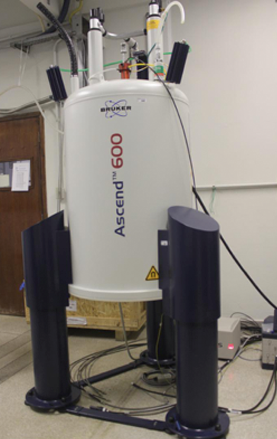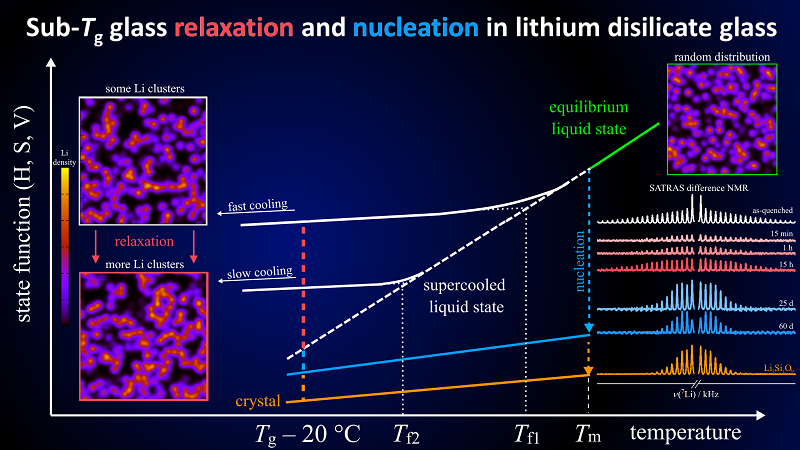
A team of researchers from CeRTEV (one of the largest academic centers for glass research in the world, located in São Carlos, SP, Brazil) has carried out the first experimental observation of the changes that occur in the structure of a glass during relaxation and nucleation, two processes that occur at the nanometer scale in all glasses and that impact their properties.
It is worth remembering that glasses are amorphous materials: their atoms do not appear in an organized and periodic arrangement. Furthermore, they are out of thermodynamic equilibrium and therefore tend to seek stability. In that search, the structure of the glasses undergoes rearrangements, which tend to either make it more fluid (relaxation), or to form the first crystals (nucleation) to, finally, crystallize.
In addition to occurring spontaneously (at the end of almost infinite human times at room temperature), the relaxation and crystallization of glasses can be greatly accelerated by heating the material, which is the method used to produce glass-ceramics. Much more resistant to impacts than common glasses, glass-ceramics have crystalline regions dispersed in the amorphous matrix. Due to their unique properties, they are used in applications such as bulletproof windows and dental restorations.
Understanding the structural changes of glasses during relaxation and nucleation is an old scientific problem, whose resolution was limited by the absence of adequate instrumentation. Therefore, in order to carry out this study, the CeRTEV researchers needed to develop a method. The challenge was finally overcome using experiments based on the nuclear magnetic resonance (NMR) technique combined with computer simulations.
“Our research and the resulting technique offer a valuable tool for monitoring and understanding the relaxation process in many glasses, as well as the early stages of crystal nucleation that occur during heat treatments,” says Henrik Bradtmüller, corresponding author of the article that reports this research in Acta Materialia. “These findings are crucial for the design and production control of technologically advanced glass-ceramics with high performance ”, adds the young German scientist, who has been working as a postdoctoral fellow at UFSCar, with a scholarship of the São Paulo Research Foundation (FAPESP), since 2020.
The discovery
The joint work of highly specialized scientists was one of the keys to achieving success in this research. In fact, the work team added the broad experience of two senior researchers: Professor Edgar Dutra Zanotto (UFSCar) in the area of nucleation and crystallization in glasses, and Professor Hellmut Eckert (IFSC-USP) in the development and refinement of the new NMR technique. Also fundamental were the contributions of postdoctoral fellow Anuraag Gaddam (IFSC-USP), also a FAPESP fellow, who carried out the computational simulations, and Henrik Bradtmüller, who developed and applied the NMR strategies that made the observations possible.

“Through the use of molecular dynamics simulations, we were able to predict the structural changes that occur during glass relaxation,” says Bradtmüller. “In the present contribution we could observe these changes for the first time through sensitive NMR experiments”, he adds. The NMR technique makes it possible to analyze, on the atomic scale, the structure of solid materials, including amorphous structures.
To carry out the experiments, the team chose lithium disilicate (Li2Si2O5), a glass-ceramic widely used, mainly in dental prostheses. The researchers heated it over periods that varied between 15 minutes and 60 days, at 435 °C, a temperature lower than that of the glass transition of this material, in which the atoms gain mobility and the glass begins to become more fluid, without, however, melting.
The samples taken at different times of heating were analyzed using the developed NMR experiments. The results showed, for the first time, what happens to the structure of lithium disilicate during relaxation and nucleation. “The distribution of the network building blocks of this glass (-Si-O-Si-) stays mostly unchanged”, reports Professor Zanotto, who is director of CeRTEV. “In contrast, the network modifier cations (Li+), which are very mobile within the material at annealing temperatures, continously approach a structural configuration that resembles the crystalline state.” Given enough heating time, explains the professor, the first crystal nuclei appear, followed by many others, until the entire material is crystallized.
From now on, the authors of the work hope that the new methodology will be used to study many other vitreous materials and that this detailed understanding of fundamental phenomena will allow adjusting the properties of glass-ceramics to improve their performance and expand their range of applications.
This research was funded by FAPESP.

Paper reference: Structural rearrangements during sub-Tg relaxation and nucleation in lithium disilicate glass revealed by a solid-state NMR and MD strategy. Henrik Bradtmüller, Anuraag Gaddam, Hellmut Eckert, Edgar D. Zanotto. Acta Materialia. Volume 240, November 2022, 118318. https://doi.org/10.1016/j.actamat.2022.118318
Author contact: Edgar Dutra Zanotto – dedz@ufscar.br
